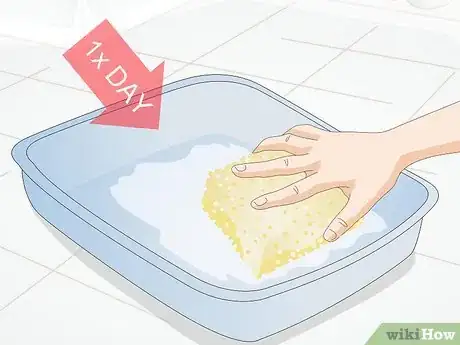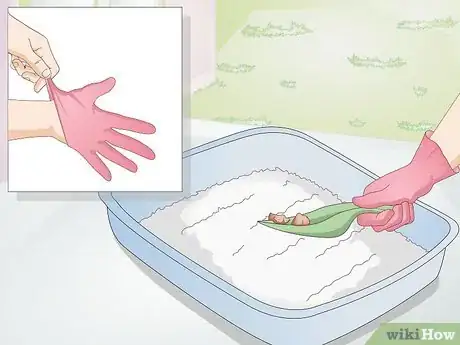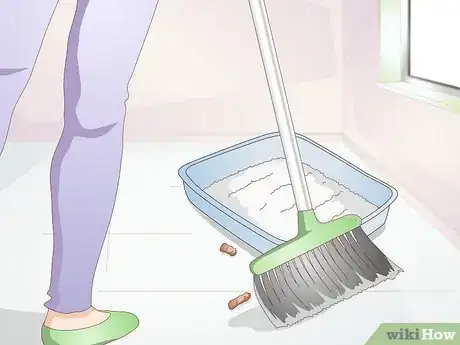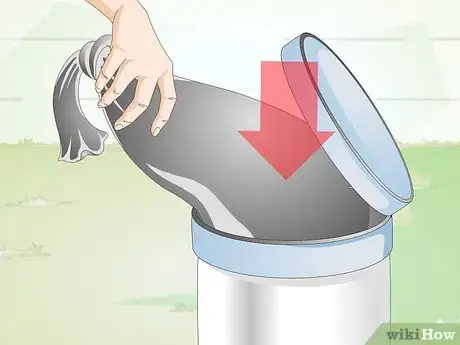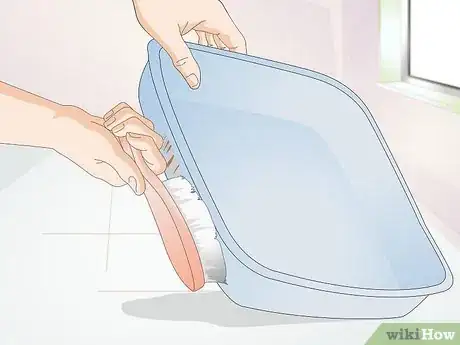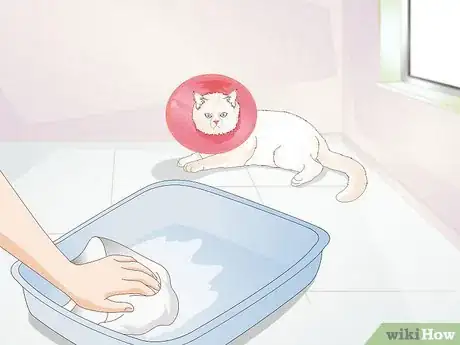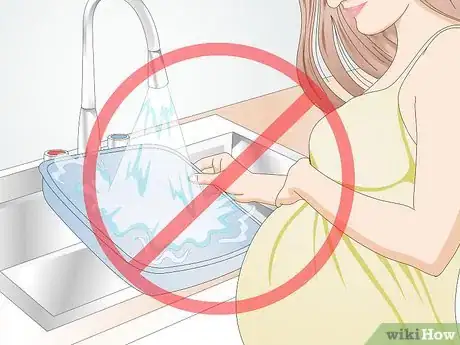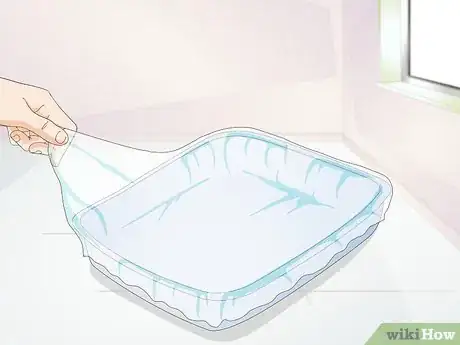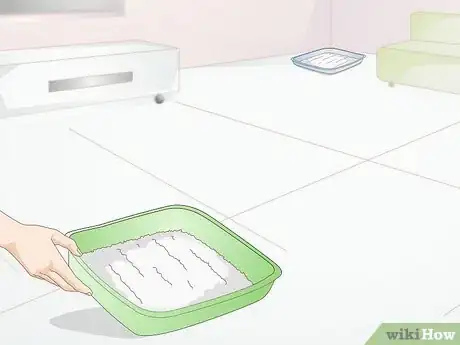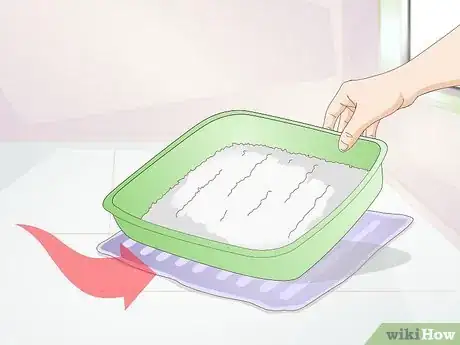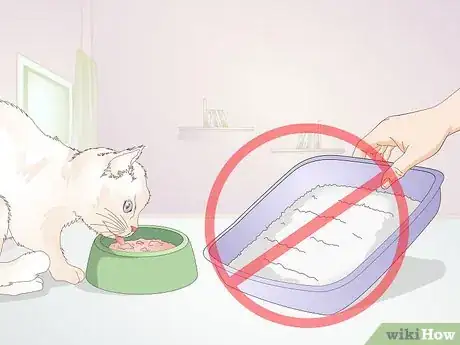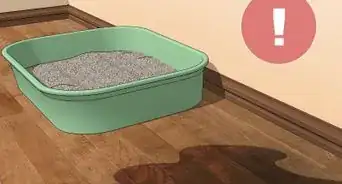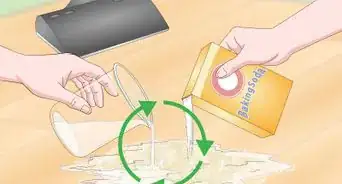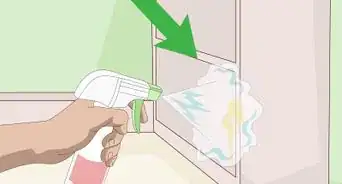This article was co-authored by Joey Lusvardi. Joey is a Cat Training & Behavior Expert and Owner of Class Act Cats based in Minneapolis, Minnesota. With five years of experience, Joey specializes in feline behavioral issues and customized treatment plans with the goal of integrating cats into their homes and families. Joey is a Certified Cat Behavior Consultant through the IAABC and a member of the Pet Professional Guild.
There are 9 references cited in this article, which can be found at the bottom of the page.
This article has been viewed 20,530 times.
Cleaning a litter box is a necessary chore. Though a litter box is a safe, clean way for your indoor cat to use the bathroom, there is still the potential for germs. Learn how to safely change your cat’s litter box so you can reduce the risk of exposing yourself to germs.
Steps
Cleaning a Litter Box Properly
-
1Clean the litter box daily. Your cat will use the litter box daily. This means you should clean the litter box daily. You should not leave feces in litter boxes because they contain bacteria and parasites.[1]
- If you have more than one cat, you should clean the litter box twice a day.[2]
- Consider cleaning the litter box once in the morning and once in the evening.
- Clean litter boxes help keep cats from messing in other parts of your home, which will reduce the spread of germs.
-
2Wear gloves when scooping litter. One way you can avoid germs when you clean your cat’s litter box is to wear gloves when you clean the litter box. Put on rubber gloves or disposable latex gloves before you go to the litter box.[3]
- Keep the gloves on while you handle any waste or soiled litter.
- Throw the gloves away afterwards. If you are wearing reusable rubber gloves, wash them in scalding hot water and detergent, or a mild bleach solution.
Advertisement -
3Wear a mask. If you are concerned about the spread of germs, wear a mask when you clean your litter box. Wearing a mask can help protect you from inhaling any airborne germs. It may also help reduce the amount of litter dust you inhale.
- If your litter has a lot of dust, you may consider wearing goggles, too.
- You may consider using a mask if you are immunodeficient or undergoing chemotherapy for cancer.
-
4Wash your hands after cleaning the litter box. If you don’t want to wear gloves, or even if you have worn gloves, you should wash your hands thoroughly after cleaning the litter box. Never skip washing your hands because that can lead to the spread of any infections or parasites.[4]
- Wash your hands if you touch any dirty litter, or if you touch any feces or urine.
-
5Sweep up any spillover. If your cat has kicked any litter out of the box, sweep up the litter and dispose of it. If any waste has also been pushed out of the box, disinfect the area.[5]
- You should disinfect the area around the outside of the litter box periodically. This includes the floor and the spill mat.
- Disinfect with hot water and a gentle cleaner like unscented dish soap.
-
6Clean the scoop. The scoop you use for cleaning the litter box should be used only for that purpose. Periodically, you should clean the scoop with hot water and detergent or a mild bleach solution.[6]
- You should never wash the scoop in a bathroom or kitchen sink.
- Make sure to remove any feces that is left behind on the scoop.
- When you are not using the scoop, consider keeping it in a plastic bag or covering the head another way. This helps prevent any germs on the scoop from spreading.
-
7Dispose of the cat litter properly. After cleaning out your litter box, you need to dispose of the cat litter in a hygienic way. Don’t just toss it into the trash can. Instead, place it in a separate plastic bag. Then, tie the plastic bag shut to keep the contents from spreading. Place it in your trash can.
Disinfecting Your Litter Box
-
1Disinfect the litter box every few weeks. To keep the germs and odors down, plan on disinfecting and scrubbing your litter boxes every few weeks. You should do this with a mild bleach solution.[9]
- When you disinfect the litter box, remove all the cat litter. Scrub the bottom and edges of the litter box with a mild-bleach solution. To make a mild bleach solution, add ½ cup of bleach to one gallon of water.
- You can also clean the litter box with hot water and detergent.
- Make sure to clean the area you scrubbed the litter box after you finish cleaning the litter box to decrease germs.
- Never clean a litter box in the kitchen or around any place you prepare food.[10]
-
2Scrub the litter box if it gets soiled on the sides. Sometimes, your cat may end up pushing her waste around so that it gets smeared or caked on the sides of the litter box. If you see feces or urine sticking to the edge of the litter box, scrub down the litter box.[11]
- Remove all the cat litter from the box and remove the waste with a mild bleach solution.
-
3Clean the litter box frequently if the cat is sick. Since your cat can spread germs, parasites, and bacteria through her waste, you want to make sure to take special care when your cat is sick. If your cat has an infection that can be spread through waste, or has something like worms, you should clean the litter box more often.[12]
- If you have other cats, you may want to clean the litter box every day or every few days until the infected cat is better. This can help reduce the risk of your other cats from getting sick.
-
4Locate the litter box on a hard, easily cleaned surface. You should place the litter box on a floor surface that is easy to clean. This may be tile or linoleum. You want to make sure you can easily remove any mess if there are accidents or waste gets on the floor.[13]
- Don’t set the litter box on carpet. Cleaning waste out of carpet is difficult, and the fibers may hold bacteria. The same is true about hardwood floors.
Considering Other Litter Box Concerns
-
1Avoid cleaning litter boxes if pregnant. Women who are pregnant should not clean litter boxes. Cats may carry a parasite that causes a condition called toxoplasmosis, which may cause birth defects.[14]
- If a pregnant woman does not have someone to change the litter box for her, she can wear rubber gloves while changing the litter box. After changing the litter box, the pregnant woman should wash her hands afterwards well.[15]
-
2Consider disposable liners or trays. If you don’t want to worry about cleaning and disinfecting the litter box, consider using disposable liners for the litter box. These liners are removed when you change the litter. You can also get a disposable litter box that you throw away every few days.
- This choice may be a good idea if you are immunocompromised or undergoing chemotherapy.
-
3Provide an adequate number of litter boxes. Cats like to bury their waste under dirt or litter. Because of this, cats tend to like their own litter box. A good rule is to have one more litter box than the total number of cats that you have.[16] For example, if you have three cats, then you should have four litter boxes.
- Sometimes, cats may share litter boxes. For example, if you have three cats, you may get away with two litter boxes, or be able to use three litter boxes for four cats. However, some cats may find this stressful and prefer their own box.
- Watch your cats to see if the litter boxes you have provided is adequate. If your cats go to the bathroom outside the litter box, you may need another litter box. Going to the bathroom outside the litter box may also be an indication that the cat needs to go to the vet.
-
4Place a spillover mat. To help keep germs and mess at a minimum, consider placing a spillover mat under or in front of the litter box. This can catch any litter your cat pushes out of the litter box or that gets stuck on her feet.[17]
- Choose a mat that is easily cleaned. Consider plastic or another surface that you can wipe down easily with a disinfectant.
-
5Refrain from placing the litter box near the cat’s food. You want to place the litter box in an area of your home separate from where you feed your cat. Cats generally don’t like it, and there is a higher chance of cross-contamination between food and the litter box, increasing the risk of spreading germs.[18]
- Consider putting the food in the kitchen and putting the litter box in the bathroom or laundry room.
References
- ↑ http://www.cdc.gov/Features/HealthyPets/
- ↑ http://www.communityconcernforcats.org/resources/litter-box-behavior/
- ↑ http://www.ncbi.nlm.nih.gov/pmc/articles/PMC2817764/
- ↑ http://www.ncbi.nlm.nih.gov/pmc/articles/PMC2817764/
- ↑ http://www.wormsandgermsblog.com/files/2008/04/M2-Litter-Box.pdf
- ↑ http://www.wormsandgermsblog.com/files/2008/04/M2-Litter-Box.pdf
- ↑ https://your.kingcounty.gov/solidwaste/ecoconsumer/documents/SeattleTimes_2015-04-04.pdf
- ↑ http://www.seattle.gov/util/EnvironmentConservation/MyHome/PreventPollution/PetWaste/index.htm
- ↑ http://www.communityconcernforcats.org/resources/litter-box-behavior/
- ↑ http://www.wormsandgermsblog.com/files/2008/04/M2-Litter-Box.pdf
- ↑ http://www.communityconcernforcats.org/resources/litter-box-behavior/
- ↑ http://www.communityconcernforcats.org/resources/litter-box-behavior/
- ↑ http://www.communityconcernforcats.org/resources/litter-box-behavior/
- ↑ http://www.cdc.gov/Features/HealthyPets/
- ↑ http://www.dettol.co.uk/healthy-homes/pets/pet-specific-cleaning-issues/
- ↑ http://www.communityconcernforcats.org/resources/litter-box-behavior/
- ↑ http://www.communityconcernforcats.org/resources/litter-box-behavior/
- ↑ http://www.communityconcernforcats.org/resources/litter-box-behavior/
About This Article
When cleaning a litter box, you can avoid germs by wearing gloves and a face mask. If you wear reusable rubber gloves, be sure to wash them in scalding hot water and detergent, otherwise, use a new pair of disposable gloves every time you clean the litter box. As for the scoop, wash it just like you did your gloves and keep it in a sealed plastic bag to prevent any germs from spreading. After your litter box is cleaned, dispose of the litter in its own trash bag, which should get tied and placed directly into the trash can. For more advice from our Veterinary co-author, like how to disinfect your litter box, read on!
